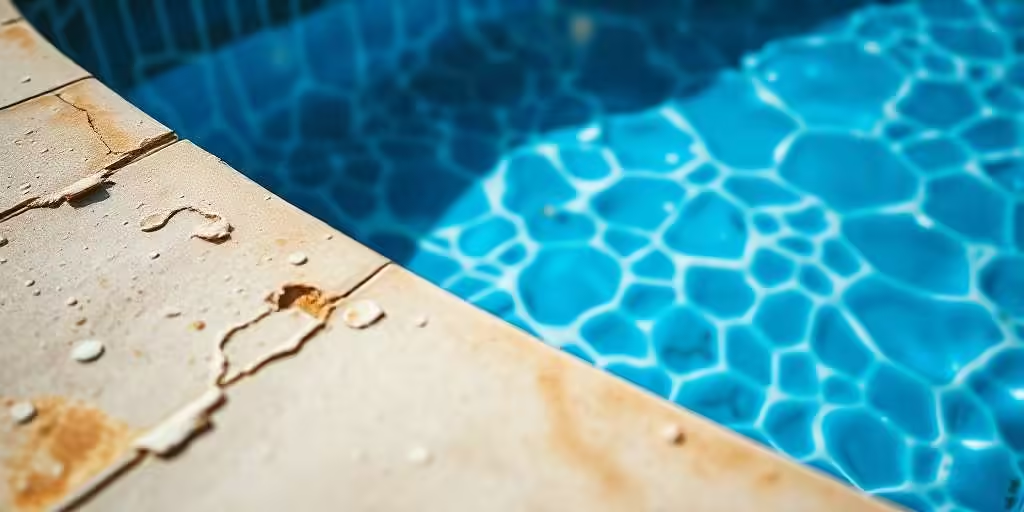Osmosis is a phenomenon that affects polyester and fiberglass pools. It occurs when water infiltrates through the liner, causing damage to the structure and appearance of the pool. This problem can arise from a variety of causes, such as construction deficiencies and environmental factors. Understanding osmosis is essential in order to implement effective solutions and ensure the durability of the pool.
Understanding Osmosis in Swimming Pools
The phenomenon of osmosis is crucial to understand the problems that can arise in polyester and fiberglass pools. Its study allows us to identify the causes and consequences of this process in aquatic structures.
Definition and basic principles
This is a movement of water through a semi-permeable membrane, where the liquid moves from a less concentrated solution to a more concentrated one. In the context of swimming pools, this process can lead to significant liner problems.
Differences between polyester and fiberglass pools
Both types of pools use different materials that affect their performance under osmosis. Polyester pools are generally more susceptible to degradation, while fiberglass, despite its resistance, is not exempt from this phenomenon.
Impact of osmosis on the pool structure
When osmosis occurs, the effects can be serious. The water pathway can alter the structural integrity of the pool, resulting in visible and functional damage.
Formation of blisters and lumps
One of the most obvious signs of osmosis is the appearance of blisters and bumps on the surface of the coating. These elevations are the result of accumulated water pushing the gelcoat outward.
Structural deformities and materials affected
Over time, the accumulation of water puts pressure on the structure, which can lead to deformation. The affected materials often lose their strength, compromising the overall durability of the pool.
Common Causes of Osmosis
Understanding the causes of osmosis is essential to prevent damage to polyester and fiberglass pools. Construction deficiencies and environmental factors are the main reasons contributing to this phenomenon.
Construction deficiencies
The quality of the work performed during pool construction is crucial. Inadequate workmanship can lead to significant long-term problems.
Use of low quality materials
Unsuitable materials may not offer the necessary resistance to water pressure. This facilitates the entry of moisture, promoting osmosis.
Problems during the application process
Poor air evacuation during air evacuation during coating application can create air bubbles that become vulnerable points. This increases the risk of water infiltration.
Environmental factors
The influence of the environment is also a determining factor in the occurrence of osmosis. There are several conditions that can aggravate this problem.
Groundwater pressure
High water table generates excessive pressure on the pool structure, which facilitates water penetration through the liner.
Extreme weather conditions
High temperatures or sudden changes in climate can accelerate the deterioration of materials, favoring the emergence of osmosis.
Effects of Osmosis in Polyester and Fiber Pools
The effects of osmosis in polyester and fiberglass pools can be significant and worrisome. This situation can lead to serious consequences if not properly addressed.
Degradation of the coating
The presence of osmosis contributes to the degradation of the pool liner. Inferred materials, such as gelcoat, are compromised, resulting in a deteriorated appearance. Over time, the outer layer may lose its original luster, affecting the aesthetic appreciation of the aquatic space.
Increased leaks and water loss
Another notable effect is the increase in leakage, which results in significant water loss. This situation not only makes it difficult to properly maintain the water level, but also increases operating costs.
Impact on the aesthetics and value of the property.
Osmosis can have an impact on the overall aesthetics of the pool. The appearance of blisters, lumps and deformities not only affects the appearance, but can also negatively influence the value of the property. A pool in poor condition can significantly decrease its value in the real estate market.
Effective Prevention Methods
Implementing preventive measures is essential to ensure the longevity of polyester and fiber pools. The following are the most effective strategies to minimize the risk of osmosis.
Regular inspections and monitoring
Periodic checks can identify early signs of problems. Inspecting both the gelcoat surface and the seams and seals is essential to detect lumps or blisters before they become a major problem.
Water table control
Maintaining a proper surrounding water level is essential. This not only prevents excessive pressure on the structure, but also helps prevent water infiltration that can affect the pool.
Improved drainage around the pool
A well-designed drainage system minimizes water retention. Implementing effective drains around the pool is a key action to prevent moisture accumulation.
Surface and subsurface drainage
Having drains both at the surface and at deeper levels ensures adequate water evacuation. This is crucial to reduce the risk of hydrostatic pressure in the structure.
Preventive waterproofing
Making sure the pool is properly waterproofed from the start is vital. Using quality products during construction can make a big difference in the long run.
Use of epoxy and fiberglass resins
Applying epoxy resins and fiberglass coatings in the construction provides a solid barrier against water infiltration, improving the durability of the coating.
Osmosis Solutions and Treatments
There are several strategies to address osmosis problems in polyester and fiber pools. Implementing proper treatments is essential to restore the structural and aesthetic integrity of the pool.
Remediation of the affected structure
This initial process is essential to eliminate any damage caused by water infiltration. It involves several key steps.
Gelcoat removal techniques
Methods such as compressed air blasting can be used to remove the damaged gelcoat. These techniques ensure that the affected layer is removed without compromising the underlying layers.
Thorough washing for waste disposal
After the gelcoat has been removed, a thorough wash should be performed to remove all chemical residues. This prepares the surface for the next step in the treatment.
Primer application and puttying
After renovation, priming is crucial. This is complemented by puttying to ensure a suitable base for new coatings.
Lining with reinforced liner
As an economical alternative, a reinforced liner lining can be used. This solution provides effective waterproofing.
Benefits of pool liner
- It offers a guarantee of at least ten years of watertightness.
- Facilitates installation and long-term maintenance.
- Improves the overall aesthetics of the pool.
Restoration of the original gelcoat
If you choose to restore the gelcoat, it is necessary to apply new coats over the prepared surface. This will not only return the pool to a renewed appearance, but will also reinforce the protection against future leaks.
Collaboration with Professionals
The intervention of experts in the maintenance and repair of swimming pools is essential to address osmosis problems. Their specialized knowledge ensures the best care of the structure and its long-term functionality.
Expert evaluation of pool condition
It is essential to have the opinion of qualified professionals who can make an accurate diagnosis of the situation of the pool. This evaluation includes:
- Thorough visual inspection of the coating and joints.
- Detection of blisters and lumps indicating osmosis problems.
- Assessment of surrounding environmental conditions.
Repair and maintenance advice
Specialists offer guidance on best practices for restoring and maintaining distressed pools. Their advice can cover:
- Recommendations on effective sanitation techniques.
- Projection of a regular maintenance schedule.
- Advice on the use of appropriate chemicals.
Selection of suitable materials and solutions
Using quality materials is essential to prevent future inconveniences. Experts can help in the choice of:
- Epoxy resins and other durable coatings.
- Components for drainage and waterproofing.
- Coatings that offer guarantees in terms of watertightness.


